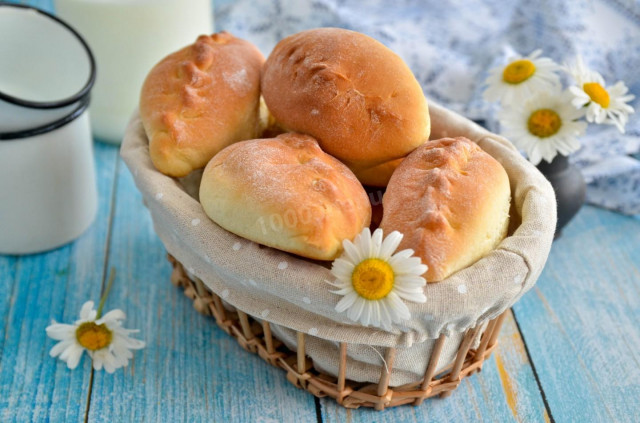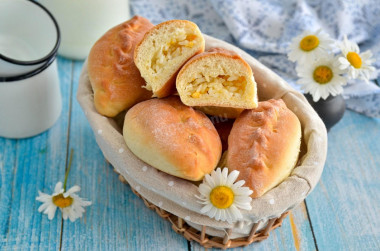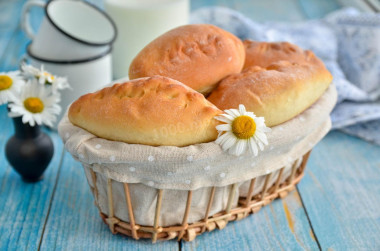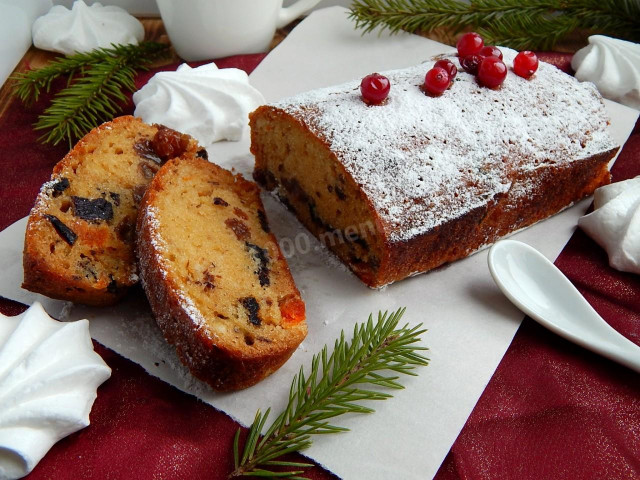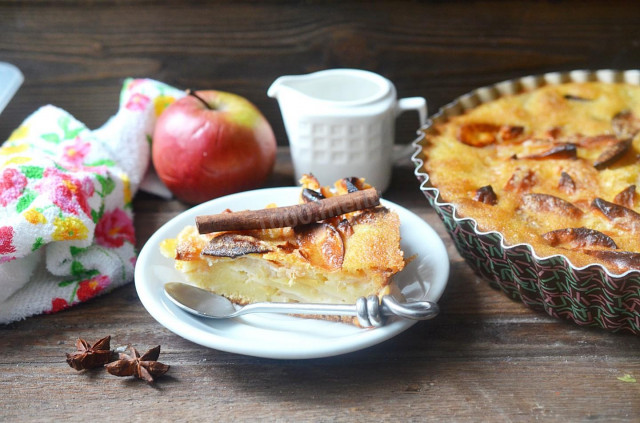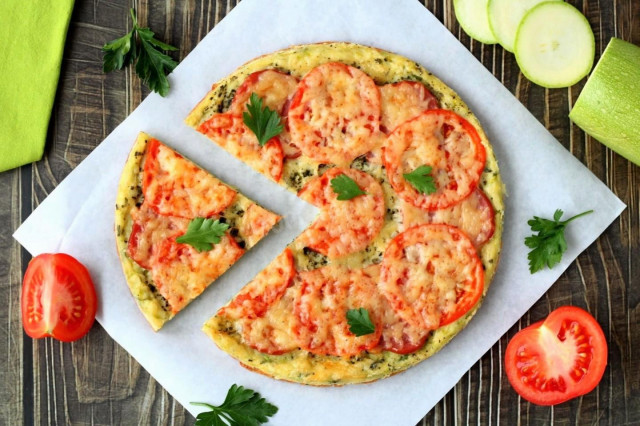Composition / ingredients
Step-by-step cooking
Step 1:

Prepare the dough preparation products. This amount will make 12 small pies.
Step 2:
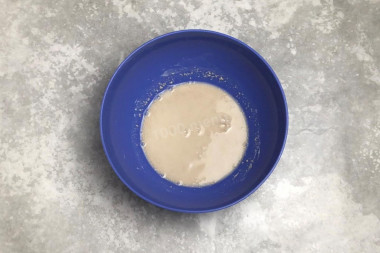
First you need to activate the yeast. Take a bowl, pour warm water into it, the temperature is about 38 degrees. Hotter water will kill yeast, which is a living organism. They just won't wake up in cold water. Put a couple of spoonfuls of flour in the water, mix. Pour in the yeast, mix with a whisk.
Step 3:

Cover the bowl and leave for 15-20 minutes. A foam cap should appear on the surface of the water - this means that the yeast is active, they have woken up and are ready to work.
Step 4:

Sift flour into another bowl. Sifting saturates the flour with air, which will make the baking softer and fluffier. do not skip this step, especially when preparing yeast dough.
Step 5:

Add salt and sugar to the flour, mix.
Step 6:
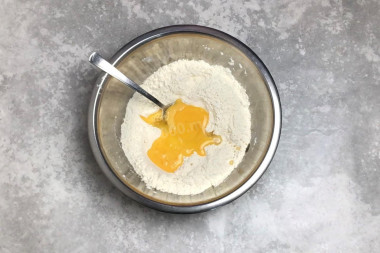
In a separate cup, lightly beat the egg with a fork, pour it into the flour. Pour vegetable oil into the same place.
Step 7:

Add the yeast sponge last. Knead the dough. First, just stir it with a spoon. When it becomes difficult to stir, connect your hand. It is convenient to do it right in the bowl. Do not add more flour - the dough will be sticky, but it should be. It will remain soft in the finished product. better put on a glove. Or knead the dough with a mixer.
Step 8:
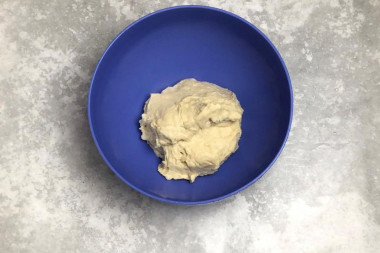
When the dough becomes smooth and homogeneous, assemble it into a ball and put it in a clean bowl. Cover the bowl and put the dough in a warm place to rise for one and a half to two hours.
Step 9:

While the dough is rising, prepare the filling. Boil the eggs in advance. It is better to use round-grain rice, not steamed.
Step 10:
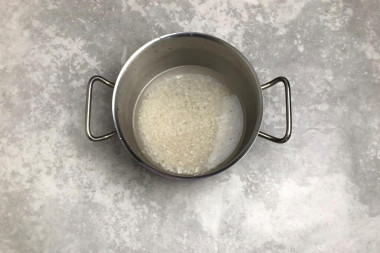
Rinse the rice well in several waters. Fill it with cold water in a ratio of 1:1.5 (one and a half portions of water for one part of rice) and put it to cook over high heat. As soon as the water boils, reduce the heat to a minimum. Cook the rice for 15 minutes under a closed lid. Then turn off the fire. without opening the lid of the pan, leave the rice for another 15 minutes.
Step 11:
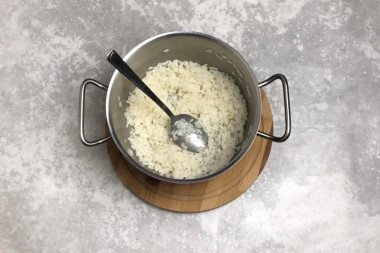
Put butter in the finished warm rice. Mix it up.
Step 12:
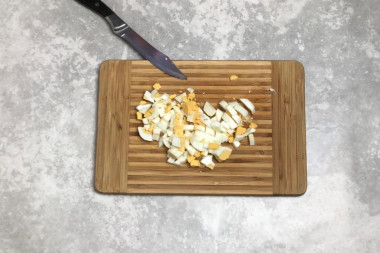
Peel and chop the eggs.
Step 13:
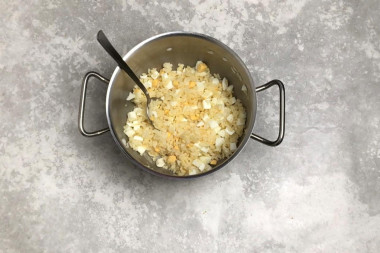
Add eggs to rice. Add salt to taste. Mix it up. The filling is ready.
Step 14:
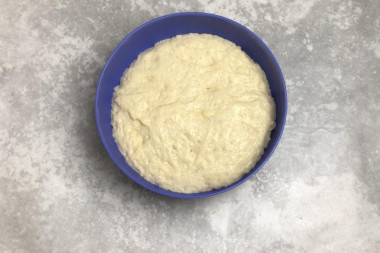
The dough should double in size.
Step 15:
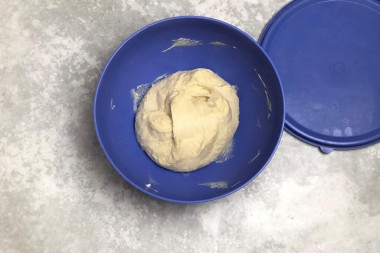
Obomnite it - assemble it into a ball again.
Step 16:
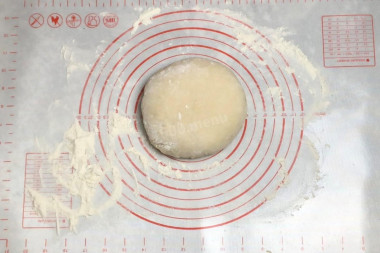
Place the dough on a work surface dusted with flour. Knead it a little.
Step 17:
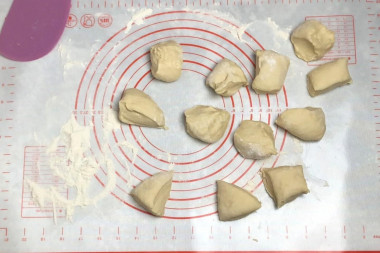
Divide the dough into 12 equal parts.
Step 18:

Round each part. To do this, assemble the edges to the center with a knot, turn the seam down and roll the workpiece, forming a ball.
Step 19:
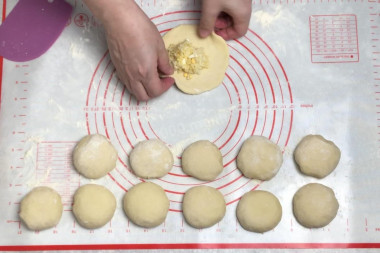
Roll each ball into a circle, about 5 mm thick. Put a tablespoon of filling in the center.
Step 20:

Pinch the edges of the pie. If desired, wrap the seam figuratively.
Step 21:

Form all the pies in this way. Place them on a baking sheet lined with baking paper. I put the pies too close to each other. It is better to divide their number into two baking sheets and leave a large distance between them - the pies will grow greatly.
Step 22:

Cover the baking sheet with a towel and leave the pie to come up for 15-20 minutes.
Step 23:

Preheat the oven to 180 °C, top-bottom mode. Bake the pies for about 25 minutes until golden brown. Cool the hot pies on the grill.
I'm thrilled with this test. From the minimum number of products, practically without muffins, it turns out very lush and soft!
I would increase the amount of filling, it seemed to me that there is more dough in the pie than the filling.
The liquid in which yeast is bred should be pleasant to the touch, no higher than 40 degrees. Why is this important? In a warm environment, yeast is well activated, in a hot one it will die, and in a cold one it simply will not work. To avoid unpleasant surprises, check the yeast before mixing with the rest of the ingredients. Pour a little warm milk into a bowl, stir in the yeast. Cover the bowl with a kitchen towel and put it in a warm place without drafts for 10-15 minutes. During this time, a foam yeast cap should appear on the surface of the sponge. If this did not happen, then the fermentation process has not started (the yeast is overdue or spoiled). In this case, it is worth taking other yeast, otherwise baking will not work.
Keep in mind that everyone's ovens are different. The temperature and cooking time may differ from those specified in the recipe. To make any baked dish successful, use useful information about the features of ovens !
In order for the oven to have time to heat up to the desired temperature, turn it on in advance (10-20 minutes before the start of cooking).
For cooking, it is better to use filtered or bottled water that is neutral to taste. If you use tap water, keep in mind that it can give the dish an unpleasant characteristic taste.
Important! Using dry yeast, it should be borne in mind that they occur in two forms: active and instant (read the instructions carefully before use!).
Active dry yeast looks like beads or small balls. Before applying them, they must be brought out of "sleep mode". To do this, the active yeast is diluted in warm sweet water, milk or whey. The resulting bubbles, foam or "cap" indicate that the yeast is ready for further use. Active dry yeast must be brought to complete dissolution in the liquid, otherwise, due to the remaining grains, the dough may not rise and the baking will be spoiled (yeast grains that have not dissolved in the liquid and got into the dough will not disperse on their own, which means they will not work).
Instant dry yeast is easier to use. They do not need to be activated before use. Such yeast, along with other ingredients, is simply added to the dough. As a result, the baking time is reduced.
It should also be remembered that both types of dry yeast may differ in their activity from different manufacturers.
Caloric content of the products possible in the composition of the dish
- Chicken egg - 157 kcal/100g
- Egg white - 45 kcal/100g
- Egg powder - 542 kcal/100g
- Egg yolk - 352 kcal/100g
- Ostrich egg - 118 kcal/100g
- Raw wild rice - 353 kcal/100g
- Brown raw rice - 360 kcal/100g
- Boiled brown rice - 119 kcal/100g
- White fortified raw rice - 363 kcal/100g
- White fortified boiled rice - 109 kcal/100g
- White rice, steamed, with long grains raw - 369 kcal/100g
- Steamed white rice, boiled with long grains - 106 kcal/100g
- Instant dry rice - 374 kcal/100g
- Instant rice, ready to eat - 109 kcal/100g
- Fig - 344 kcal/100g
- Whole durum wheat flour fortified - 333 kcal/100g
- Whole durum wheat flour universal - 364 kcal/100g
- Flour krupchatka - 348 kcal/100g
- Flour - 325 kcal/100g
- Granulated sugar - 398 kcal/100g
- Sugar - 398 kcal/100g
- Butter 82% - 734 kcal/100g
- Amateur unsalted butter - 709 kcal/100g
- Unsalted peasant butter - 661 kcal/100g
- Peasant salted butter - 652 kcal/100g
- Melted butter - 869 kcal/100g
- Vegetable oil - 873 kcal/100g
- Salt - 0 kcal/100g
- Water - 0 kcal/100g
- Dry yeast - 410 kcal/100g

